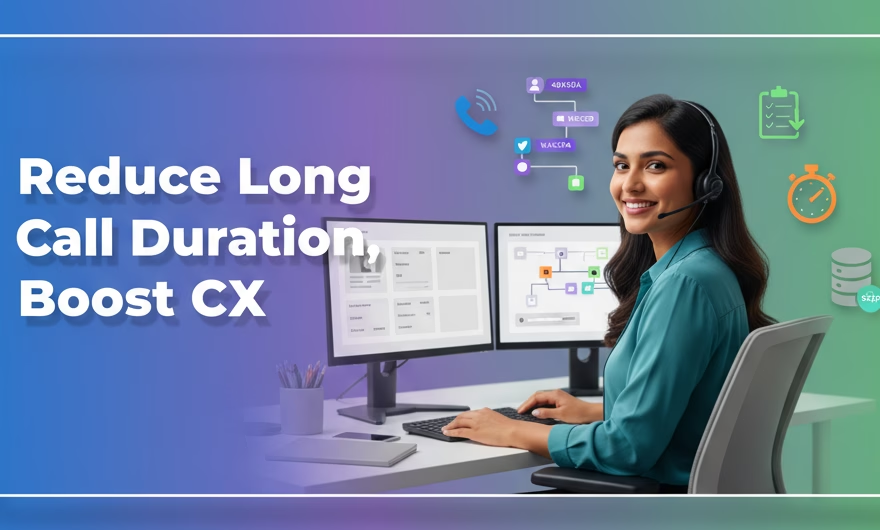Fundamental causes of excessively long call durations should be solved at the root. A handful of avoidable call center mistakes can stretch conversations far beyond what’s necessary—frustrating customers and agents alike. In contact centers, this often shows up as long call handle time (AHT), which typically includes talk time, hold time, and after-call work. Reducing AHT without compromising quality means removing friction, giving agents context, and empowering them to resolve issues the first time—especially with the right call center software.
Root Causes of Long Call Duration
Difficulty in retrieving client information
To solve a customer’s issue, agents need instant access to context—contact history, identity, and account information. When this information isn’t readily available or is spread across multiple screens, agents end up asking customers to repeat details, spell their names, or recite account numbers digit by digit. That slows the interaction and increases handle time.
The solution is to improve systems and workflows so customer context is available the moment the call connects. Consider:
- Unified agent desktops: Consolidate CRM, ticketing, and knowledge base into one view to reduce tab-hopping and re-entry.
- CTI screen pops: Use caller ID and IVR inputs to display the right customer profile, open tickets, and previous interactions automatically.
- Clean data and smart search: Ensure data quality and implement fast, fuzzy search to find records even with partial input.
- Context sharing across channels: Bring in email/chat history so agents don’t ask customers to repeat themselves when they switch channels.
- Secure shortcuts: Use templates, autofill, and single sign-on to reduce clicks and login delays while maintaining compliance.
When agents can retrieve the right information in seconds, long call handle time drops naturally, and first-contact resolution improves.
Unsatisfactory routing
Many organizations rely on IVR and skills-based routing to connect callers with the best-suited agents. In practice, though, callers are often routed incorrectly the first time, leading to transfers and repeated explanations. Every transfer resets the conversation and extends total handle time, while damaging customer confidence.
Strengthen routing so customers reach the right expert on the first try:
- Intent-aware IVR: Use clear, concise menus and capture intent keywords to guide callers accurately. Keep trees shallow to avoid menu fatigue.
- Skills and proficiency routing: Go beyond role labels—route by verified proficiency, certifications, language, and product tier.
- Contextual data routing: Use account status, recent tickets, or purchase history to prioritize routing to specialized teams.
- Callback and queue transparency: Offer call-backs during peaks to reduce abandonment and keep talk time focused on resolution, not waiting.
- Continuous tuning: Review transfer reasons and IVR exits regularly; simplify options that create confusion and add missing paths where needed.
Better routing reduces unnecessary transfers, repetition, and hold time—key contributors to long call handle time.
Scripted and rigid approach to interaction
Scripts protect compliance and brand tone, but when agents can’t deviate to address the actual problem, conversations become robotic and slow. A yes/no script that funnels callers through predefined branches often misses the core issue, stretching the interaction and lowering satisfaction.
Keep scripts as guardrails, not handcuffs:
- Dynamic guidance: Use decision trees and knowledge articles that adapt to customer responses rather than fixed scripts.
- Agent empowerment: Grant authority for common exceptions—refund thresholds, plan changes, or policy waivers—to avoid escalations.
- Next-best-action prompts: Provide real-time tips and checklists based on intent and customer profile to speed diagnosis and fix.
- Soft-skill coaching: Train agents to clarify intent early, summarize, and confirm—techniques that cut loops and rework.
- Measure what matters: Balance AHT with first-contact resolution and CSAT. Reward accurate, efficient resolutions, not speed alone.
When agents can blend structure with judgment, they handle calls faster without sacrificing service quality or compliance.
After-call work takes longer than expected
Wrap-up tasks—entering notes, selecting dispositions, updating systems—often consume more time than they should. If agents must navigate multiple tools or write free-form summaries from scratch, after-call work balloons, increasing overall handle time and delaying readiness for the next customer.
Streamline ACW to shorten long call handle time:
- Structured dispositions and templates: Standardize wrap-up categories and note templates so agents document quickly and consistently.
- Auto-population from context: Pre-fill fields from CRM records, IVR inputs, and call outcomes to minimize typing.
- Automated summaries: Use tools that generate concise call summaries and action items for agent review, reducing manual note-taking.
- Single-click workflows: Trigger follow-ups—emails, tickets, callbacks—with predefined rules to eliminate redundant steps.
- Quality feedback loops: Identify frequent ACW bottlenecks and fix the process or UI rather than coaching around the problem.
Optimizing wrap-up accelerates the end of one interaction and the start of the next, shrinking AHT without losing context.
Balancing Policies: Customer-Centric vs. Call Duration
Shortening calls is good business, but a blanket “shorter is better” policy can backfire in customer-centric environments. Pushing agents to rush often leads to callbacks and escalations—ironically increasing long call handle time in aggregate and harming loyalty.
The right approach is to remove friction while preserving quality. Consider these guiding principles:
- Prioritize resolution over speed: Set targets that combine AHT with first-contact resolution and quality scores. Make it clear that a slightly longer call that prevents a callback is a win.
- Segment by intent: Different intents have different ideal handle times. Simple balance checks should be quick; complex technical fixes may require more time. Measure each against its own benchmark, not one average.
- Design for zero repetition: Invest in data access, routing, and context sharing so customers never have to repeat themselves—across agents and channels.
- Coach with evidence: Use call reviews to pinpoint moments of avoidable silence, unclear questioning, or tool delays. Fix processes before focusing on individual speed.
- Protect the customer experience: Limit hold times, offer callbacks when research is required, and provide proactive status updates instead of keeping customers on the line.
Ultimately, the goal is to reduce unnecessary duration by streamlining processes and enabling smarter conversations—never by rushing customers off the phone.
Reduce time by removing friction, not by rushing—and always balance AHT with resolution and quality.
Key Takeaways
- Inadequate systems for accessing customer information increase call time—unify tools, enable screen pops, and improve search to cut delays.
- Inefficient routing leads to unnecessary transfers and repetition—optimize IVR, use skills and intent, and tune based on real transfer patterns.
- Overly scripted interactions prevent agents from addressing real issues quickly—provide dynamic guidance and empower exceptions within guardrails.
- Excessive after-call work delays readiness for the next call, increasing overall handling time—standardize dispositions, automate summaries, and reduce manual steps.
- Balancing call duration with customer experience is crucial—reduce time by removing friction, not by rushing, and measure AHT alongside resolution and quality.
By focusing on these points, call centers can reduce unnecessary long call durations—and long call handle time—without turning their backs on a customer-centric approach. Equip agents with context, streamline routing and wrap-up, and align metrics with outcomes. The result is faster resolutions, happier customers, and more confident agents.




